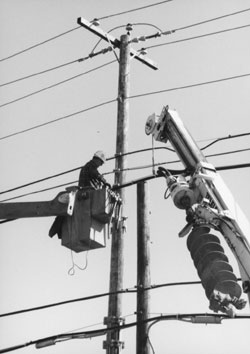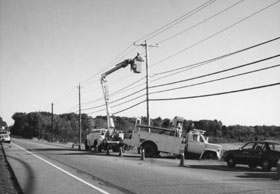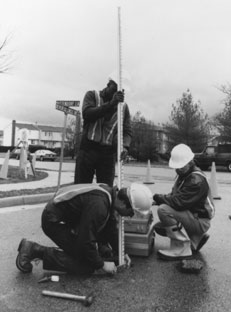U.S. Department of Transportation
Federal Highway Administration
1200 New Jersey Avenue, SE
Washington, DC 20590
202-366-4000
Focus
| Accelerating Infrastructure Innovations |
Publication Number: FHWA-RD-02-011
Date: June 2002
Utility-related problems are a leading cause of delays for highway construction projects, according to a recent National Cooperative Highway Research Program study. With record numbers of infrastructure capital improvement projects coinciding with mergers and downsizing on the part of utilities, making an increased effort to avoid delays is more important than ever. A new video available from the Federal Highway Administration (FHWA), CCC: Making the Effort Works!, is here to help.
Developed by FHWA in cooperation with the American Association of State Highway and Transportation Officials' Highway Subcommittees on Construction and Right-of-Way and Utilities, the video outlines ways in which State transportation departments and utility engineers can reduce utility-related disruptions, minimize costs, and accelerate construction. For example, the proper use of data obtained using subsurface utility engineering (SUE) can help agencies avoid the need to relocate many utility lines. SUE uses surface geophysical techniques to identify the presence and approximate position of underground utilities. The utility lines can then be exposed so that precise measurements can be taken and other data collected. Studies have shown that SUE typically costs less than 0.5 percent of the total project construction cost, saves more than $4 for every $1 spent, and may reduce project delivery time by as much as 20 percent. "Using subsurface utility engineering has been an important step for us," says Steve Gafford of the Georgia Department of Transportation (DOT).
 |
| Utility-related problems are a leading cause of delays for highway construction. |
When relocating utilities can't be avoided, the three "C's" come into play. Early and frequent coordination, cooperation, and communication (CCC) among State DOTs and utility personnel will result in more timely and efficient utility relocation activities. "We need to work together. We need a lot of cooperation and coordination and to make sure that our goal is to have a good project at a reasonable cost in a timely manner," says Ed Garcia, Senior Transmission Engineer for Florida Power & Light. "I'd like to see more of an effort placed on inviting utilities to participate on the front-end stage of a development project," says James J. Neal, Relocation Coordinator for Bell South. "Typically we get in at what's known as the 90 percent point. By then the corridors and infrastructure have already been defined."
 |
| Early and frequent coordination among State DOTs and utilities can reduce construction delays. |
Many State highway agencies are starting to pay more attention to cooperating and coordinating with utilities. Melinda Peters of the Maryland State Highway Administration says, "It's important to set up meetings with utilities throughout the planning and design process, so we can avoid conflicts." If telephone cables have to be moved, for example, it may take up to a year to carry out the transfer, making planning ahead crucial. To accomplish this, the State of Wisconsin has passed legislation mandating communication and coordination throughout projects and setting up a timeframe for interaction. And in South Carolina, "we schedule at least weekly meetings with utility companies and contractors to make sure that everyone is singing off the same page of the songbook. That's very helpful," says Marion Leaphart, Utilities Manager for South Carolina DOT.
 |
| Here, a test hole is dug as part of subsurface utility engineering work. |
A Viewing and Discussion Guide is available for use with the video. The Guide provides an overview of the video content, key points that may be copied and distributed to use as an ongoing reference, discussion questions, facilitator tips for leading discussions, and additional resources. To learn more about CCC and SUE or to obtain copies of the video and viewing guide, contact your local FHWA division office or Paul Scott at FHWA, 202-366-4104 (fax: 202-366-3988; email: paul.scott@fhwa.dot.gov). The Viewing Guide is also available on the Web at www.fhwa.dot.gov/programadmin/viewer.cfm.